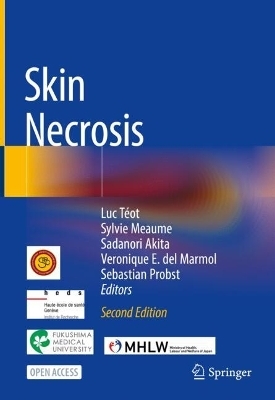
Skin Necrosis
Springer International Publishing (Verlag)
978-3-031-60953-4 (ISBN)
- Noch nicht erschienen - erscheint am 09.01.2025
- Versandkostenfrei innerhalb Deutschlands
- Auch auf Rechnung
- Verfügbarkeit in der Filiale vor Ort prüfen
- Artikel merken
This successful book, now Open Access in its second edition, was the first to discuss skin necrosis as a symptom related to a broad range of pathologies. In recent years, wound care has gained increasing recognition as a distinct medical specialty. An understanding of the complex mechanisms involved in wound healing facilitates efficient assessment and treatment of patients with wounds, and skin necrosis can be considered the starting point in the entire healing process.
Richly illustrated, this volume primarily provides therapeutic strategies and treatment algorithms for different clinical contexts, covering topics in distinct part: starting from definitions, physiopathology, vascular and imaging investigations, it then examines skin necrosis in its diverse clinical context, each assigned to a specific part: whether originated from physical injuries, of toxic origin, of medical or infectious nature, the content then shifts from the clinical context to the more specifically surgical context, and the application of existing techniques from dressing to debriding, including sharp and conservative ones. Dedicated sections deal with the pediatric and the elderly patients, closing the volume with a part on debridement education, from the perspective of the nurse and the physician, and finally a chapter on distance skin necrosis management, in the light of e-Health and personalized medicine.
All chapters were written by renowned specialists in their respected fields and include detailed sample cases and essential take-home messages; the topics that require an in-depth approach are extensively covered, whereas clinical chapters are more essential, focusing on practicality. In light of the highly interdisciplinary nature of wound management, this new, updated edition of Skin Necrosis will be a much-valued tool for wound care practitioners and health care professionals across the fields of surgery, dermatology, internal medicine, and nursing.
Luc Téot, MD, PhD, is Professor of Plastic Reconstructive Surgery and Head of the Department of Plastic Surgery, Burns, Wound Healing at Montpellier University Hospital. He has been promoting wound healing and scar management since he founded the French Wound Healing Society in 1995. He was elected president of the European Tissue Repair Society (1998-2000) and then president of the World Union of Wound Healing Societies (2004-2008). He is also president of the Academy of Wound Technology, and was coordinator of the Scar Club (2006-2017). He has contributed to 12 international books as coeditor, chapter writer or editor, is Editor in Chief and board member to related national and international journals.
Sylvie Meaume, MD, PhD, is specialized in Dermatology and Geriatrics, she is team lead at the Geriatric Unit for Wound and Scarring management, at the Hôpital Rothschild (APHP) in Paris. Vice-president of the French and Francophone Society for Wounds and Healing (SFFPC), she is also a Professor at the Sorbonne University and responsible for the University Diploma in Wounds and Scar Management at the Pierre and Marie Curie Faculty of Medicine in Paris. Sylvie Meume is the author of several books intended for all practitioners dealing with wounds, (such as surgeons, dermatologists, vascular doctors, geriatricians, pharmacists and nurses) as well as more than 150 articles in specialized journals indexed on pubmed. She is a key player in the dissemination of knowledge in the medical and scientific environment; among her contributions are countless lectures at congresses and conferences as well as presentations aimed at the general public.
Sadanori Akita is currently Professor of Fukuoka University, Faculty of Medicine and he did his residency in plastic surgery at Nagasaki University Hospital. He received his PhD from the Graduate School of Nagasaki University specializing in plastic and reconstructive surgery. He later did a research fellowship at Cedars-Sinai Medical Center, University of California, Los Angeles (UCLA) under supervision of Shlomo Melmed MD on a cytokine expression and its regulation in vivo by using a transgenic animal model. He serves as a general secretary of World Union of Wound Healing Societies, which will be held in Yokohama, September 2-6, 2012, and will be president of the world union of wound healing societies, for the years of 2012 to 2016. He is the president of the World Union of Wound Healing Societies (WUWHS) from September 2012 to September 2016 and currently the president of the Asian Wound Care Association (AWCA). His research interests include: cytokines and stem cells in wound healing, difficult wound healing (radiation injury), regenerative tissue enhancement to HIV-drug related-wasting patients, reconstructive surgery, burn and craniofacial surgery. His list of publications includes 110 peer-reviewed English original articles, 20 English overviews and 25 English-book chapters with 8 editorships of the books and lead the two study sectors funded by the Ministry of Health, Labor and Welfare on vascular anomaly and on cybernic medicine.
Veronique del Marmol is Head of the Department of Dermatology at Hospital Erasme, HUB, Université Libre de Bruxelles, Belgium. Skin cancer, inflammatory diseases, wound healing and non-invasive imaging are the main areas of interest for Professor del Marmol. In recognition of her work in these fields, she has been awarded many scholarships and grants, including the Major Roche Dermatology Fundamental Research Award. She authored and co-authored more than 215 137 peer reviewed articles and 7 books (H index 55- 12199 citations) and in particular in Experimental Dermatology, Journal Investigative dermatology, Journal of the European Academy of Dermatology and Venereology (JEADV), Nature and New England Journal of Medicine. Since 2009 she is leading at the European level the European skin cancer prevention campaign EUROMELANOMA.
Part I. Definitions, Physiopathology, Vascular and Imaging Investigations in Skin Necrosis.- 1. Introduction to Vascular and Imaging Investigations in Skin Necrosis.- 2. Dry Necrosis, Wet Necrosis: When to Debride, When Not to Debride and Practical Debridement.- 3. Ischemia/Reperfusion: A Potential Cause for Tissue Necrosis.- 4. Imaging, Vascular Assessment: Extension in Depth and Vascular Anomalies.- 5. Imaging of Hypodermal Fat Necrosis.- 6. Skin Necrosis and the Need for Vascular Assessments.- 7. Arterial and Mixed Leg Ulcer.- Part II. Different Clinical Context of Skin Necrosis Physical Injuries.- 8. Introduction to Physical Injuries in Skin Necrosis.- 9. Skin Mechanobiology: From basic science to clinical applications.- 10. Necrotic Burns.- 11. Electrical Burns.- 12. Gunshot Wounds.- 13. Frostbite.- 14. How to Manage Radiation Injuries.- 15. Excessive internal pressure (dissecting haematoma, evisceration, etc.).- 16. Telemedicine in Skin Necrosis.- Part III. Skin Necrosis of Toxic Origin .- 17. Introduction to skin necrosis of toxic origin.- 18. Resuscitation Foot Necrosis: A New Entity for a Complex Management.- 19. Skin Necrosis and Ulcers Induced by Medications.- 20. Toxic Syndromes.- 21. Skin Necrosis due to Snakebites.- 22. Skin Necrosis in Jelly fish, Stone fish.- 23. Skin Necrosis from Coma Blister (physiopath. approach).- Part IV. Skin Necrosis of Medical Origin.- 24. Introduction to Skin Necrosis of Medical Origin.- 25. Rheumatoid and Systemic Collagenosis Vasculitis.- 26. Giant Cell Arteritis.- 27. Hidradenitis Suppurativa.- 28. Martorell Hypertensive Ischemic Ulcer.- 29. Vasculitis.- 30. Necrobiosis Lipoidica.- 31. Purpura Fulminans.- 32. Protein C and Protein S Deficiencies.- 33. Renal Insufficiency and Necrosis.- 34. Calciphylaxis.- 35. Livedo(id) Vasculitis.- 36. Pyoderma Gangrenosum.- 37. Cryoglobulinemia.- 38. Necrosis of the Upper Extremities.- 39. Factitious Disorders (Pathomimia) and Necrosis.- Part V. Skin Necrosis of Infectious Origin.- 40. Introduction to Necrosis and Infection.- 41. Fusarium solani.- 42. Fournier Gangrene.- 43. Necrotizing Fasciits.- Part VI. Surgical Context of Skin Necrosis.- 44. Introduction to Skin Necrosis in a surgical context.- 45. Skin Necrosis Over Osteosynthetic Material.- 46. Necrotic Complications After Skin Grafts.- 47. Arterial Leg Ulcers.- 48. Prevention of skin necrosis in cosmetic surgery.- 49. Flap necrosis prevention using leeches.- 50. Revascularisation techniques to prevent limb amputation presenting distal necrosis.- 51. Skin reconstruction using dermal substitute after skin necrosis.- 52. Skin Necrosis of Diabetic Foot and Its Management.- 53. Skin Necrosis of Diabetic Foot and Its Microsurgical Management.- 54. Exposed Necrotic Tendons.- 55. Dissecting Haematomas in Patients Submitted to Anticoagulation.- 56. Management of the Patient After Flap Failure.- Part VII. Techniques Applicable to Skin Necrosis.- 57. Introduction to Techniques Applicable to Skin Necrosis.- 58. Dressings for Necrosed Skin.- 59. Surgical Debridement.- 60. Stabilisation of Necrotic Tissue Using Cerium Nitrate Silver Sulfadiazine.- 61. Honey Debridement.- 62. Recent Technologies in Necrosis Surgical Debridement.- 63. Regulations for Conservative Sharp Debridement for Nurse in Europe.- 64. Regulations for Conservative Sharp Debridement for Nurses in the USA.- Part VIII. Skin Necrosis in Children.- 65. Introduction to Skin Necrosis Treatment in Young Age.- 66. Skin Necrosis in Children: Physical and Infectious Causes.- 67. Neonatal Pressure Ulcer.- 68. Skin Necrosis in Children: Genodermatosis.- 69. Skin Necrosis in Children: Vascular Causes and Angioma.- Part IX. Skin Necrosis in Elderly patients 70. Introduction to Skin Necrosis Treatment in Elderly Patients.- 71. Pressure Necrosis in Geriatric Patients.- 72. Deep Dissecting Hematoma : a frequent cause of necrosis in elderly patient.- Part X. Education on Debridement.- 73. Introduction to Education on Debridement.- 74. Non-specialised nurses and debridement.- 75. how to become an expert in debridement? Nurse perspective.- 76. how to become an expert in debridement? Physician perspective.- 77. Regulations for conservative sharp debridement for nurses in Europe.- 78. Regulations for Conservative Debridement for Nurses in North America.- 79. Distance Skin Necrosis Management.
| Erscheinungsdatum | 01.11.2024 |
|---|---|
| Zusatzinfo | X, 617 p. |
| Verlagsort | Cham |
| Sprache | englisch |
| Maße | 178 x 254 mm |
| Themenwelt | Medizinische Fachgebiete ► Chirurgie ► Ästhetische und Plastische Chirurgie |
| Schlagworte | Debridement • necrosis • open access • ulcers • Wound Care • wound dressing • wound healing |
| ISBN-10 | 3-031-60953-0 / 3031609530 |
| ISBN-13 | 978-3-031-60953-4 / 9783031609534 |
| Zustand | Neuware |
| Haben Sie eine Frage zum Produkt? |
aus dem Bereich


